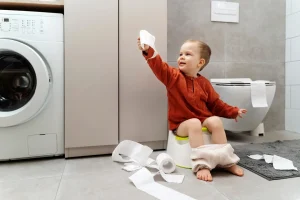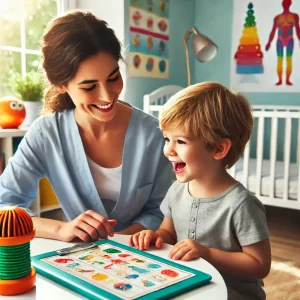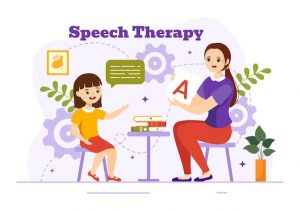Don’t Let Aphasia Silence You: 6 Effective Recovery Strategies
By Rajini D
Last Updated: April 24, 2024
Imagine waking up one day to find the words you’ve always used freely suddenly trapped in your mind, struggling to break free. This is the reality for many individuals with aphasia, a challenging condition that can transform the simple act of conversation into a frustrating puzzle. Aphasia, often resulting from a stroke or brain injury, doesn’t just steal words; it can also silently erode confidence, spark isolation, and dim the joy of connection with loved ones.
But here’s the heartening truth: While the journey to reclaiming speech can be tough, it’s far from impossible. In the realms of language lost and found again, every step forward, no matter how small, shines a beacon of hope. This article isn’t just about sharing strategies; it’s about igniting a conversation around recovery, resilience, and the undimmed brilliance of the human spirit to overcome.
Also read: Best Speech Therapy Activities For Aphasia in Adults
6. Effective Aphasia Recovery Tips
Navigating the journey of aphasia recovery can be challenging yet hopeful. The road to regaining communication skills is paved with patience, understanding, and the right strategies tailored to meet individual needs. In “6 Effective Aphasia Recovery Tips,” we delve into six pivotal areas that can significantly influence the recovery process, offering insights and practical advice to empower individuals with aphasia and their support networks.
1. Embrace Multiple Modes of Communication
In the quest to bridge the gap aphasia creates in communication, it’s crucial to remember that words are just one way we connect with each other. Alternative Communication Methods for Aphasia are not just backup options; they are vital, empowering tools that can enhance understanding and expression when traditional speech is challenging.
Non-verbal communication forms—such as gestures, drawing, or using communication boards—can significantly ease the frustration that often accompanies aphasia. These methods do more than convey messages; they open up avenues of connection that aphasia cannot close. For instance, a simple thumbs-up or shake of the head provides immediate clarity, bypassing the need for words. Similarly, pointing to pictures or symbols on a communication board can help articulate needs, thoughts, and emotions with precision.
Integrating these alternative methods into daily routines doesn’t have to be daunting. Start by incorporating simple gestures into conversations, or keep a notepad handy for quick sketches or written words. Encourage your loved one with aphasia to use whatever method feels most comfortable for them at the moment, even if it changes from day to day.
2. Simplify Communication Without Compromising Dignity
Building on the foundation of embracing multiple communication methods, it’s crucial to address how we can Simplify Communication in Aphasia without compromising the dignity of those we are trying to support. This balance is essential in nurturing an environment of understanding and respect.
When communicating with someone who has aphasia, the use of straightforward language is key. This doesn’t mean we should talk down to them; rather, we aim to make conversations as accessible as possible. Using simple sentences and clear, direct questions can help prevent confusion and make it easier for individuals with aphasia to process and respond to information.
However, simplifying communication goes beyond just the words we choose. It’s about the way we engage in conversation. Maintaining eye contact, being patient, and providing the person with enough time to respond are all critical. These non-verbal cues show respect and affirm that the individual’s thoughts and contributions are valuable and worth waiting for.
3. Enhance Understanding with Visual Aids
Moving forward in our journey to navigate the challenges of aphasia, we explore the pivotal role of Using Visual Aids for Aphasia. Visual aids aren’t just tools; they’re bridges that connect thoughts to expressions, making communication more accessible and meaningful for individuals with aphasia.
Visual aids can take many forms, from simple drawings and pictures to more sophisticated tools like communication boards or apps designed specifically for aphasia support. These aids serve as powerful allies in breaking down the barriers imposed by aphasia, offering a visual vocabulary when words seem just out of reach.
How Visual Aids Enhance Communication
- Clarity and Comprehension: A picture or symbol can convey what words may not, providing a clear understanding even when verbal communication is difficult.
- Independence in Expression: By pointing to pictures or symbols, individuals with aphasia can express their needs, feelings, and thoughts more independently, fostering a sense of autonomy.
- Reduction of Frustration: Visual aids help reduce the frustration associated with communication challenges, making conversations less stressful and more productive.
Integrating Visual Aids into Daily Life
Creating a personalized set of visual aids can be a meaningful project. Start by identifying the most common phrases, needs, and topics of conversation in daily life. These can be transformed into visual symbols, either drawn or printed, and organized into a handy booklet or a digital device for easy access.
At Wellness Hub, we encourage families and caregivers to explore and create visual aids that resonate with their loved ones’ lives. Our platform offers resources and guides on how to effectively use and create visual aids tailored to the unique needs of those navigating aphasia recovery. By providing these tools, we aim to empower both individuals with aphasia and their support networks, enhancing communication and connection.
4. Foster Incremental Learning
It’s essential to talk about the power of Learning Strategies for Aphasia and the importance of fostering incremental learning. This approach not only tailors the recovery process to the individual’s pace but also ensures that each small victory is celebrated, keeping motivation and morale high.
The Power of Incremental Learning
Recovery from aphasia is rarely a swift journey, but it’s filled with opportunities for growth and improvement. Setting realistic, achievable goals plays a crucial role in this process. These goals act as stepping stones, making the broader objective of language recovery feel more attainable and less overwhelming.
Setting Realistic Goals
- Start Small: Begin with goals that are easily achievable. This could be as simple as learning a new word each day or successfully using a communication tool during a conversation.
- Celebrate Progress: Every small achievement is a step in the right direction. Celebrating these milestones can boost confidence and encourage continued effort.
- Adjust Goals as Needed: As recovery progresses, goals should evolve to reflect new abilities and challenges. This adaptability ensures that the learning process remains relevant and engaging.
- Incorporate Varied Learning Materials: Using a mix of materials and activities can keep the learning process fresh and stimulating. This might include apps, games, books, or even conversations on topics of interest.
- Involve Communication Partners: Recovery is not a solo journey. Involving family, friends, and therapists in setting and achieving goals can provide a supportive network that encourages progress.
5. Engage in Regular, Structured Practice
Building upon the foundation of incremental learning, another pivotal aspect of aphasia recovery is Practice Techniques for Aphasia. Regular, structured practice is not just beneficial; it’s essential for reinforcing learning and facilitating progress. The journey of recovery is one of repetition and consistency, where each practice session builds upon the last.
The Role of Consistent, Structured Practice
Consistent practice helps to reinforce neural pathways, making it easier for the brain to recall and use language over time. Structured practice, on the other hand, ensures that efforts are focused and aligned with recovery goals, making the best use of time and resources.
Incorporating Practice into Daily Activities
- Set Aside Specific Times for Practice: Dedicate certain times of the day for focused practice sessions. This could be language exercises, using communication tools, or engaging in conversation with a partner.
- Integrate Practice with Everyday Activities: Language recovery can be integrated into daily life. Label household items to practice reading, narrate actions while performing tasks to practice speaking, or use written communication for planning daily activities.
- Use Technology and Resources: Take advantage of apps and online resources that offer structured practice exercises. Many of these tools provide feedback, allowing for self-assessment and adjustment.
- Engage with Others: Practice with family, friends, or in support groups. Communication is inherently social, and practicing in realistic settings can improve both confidence and skill.
- Celebrate Small Wins: Recognize and celebrate progress, no matter how small. This encourages continued effort and keeps motivation high.
6. The Concept of Music and Melodic Intonation Therapy
Music therapy, specifically (MIT), taps into the musical elements of speech — such as rhythm and melody — to facilitate verbal expression. It’s based on the observation that individuals with aphasia can often sing the lyrics of a song even when they struggle to speak the same words. This phenomenon highlights the brain’s distinct pathways for music and speech processing, suggesting that music can serve as an alternative route for communication.
Benefits of Music Therapy in Aphasia
- Enhanced Speech Production: Singing phrases and sentences can help improve articulation, rhythm, and fluency in speech, making communication clearer.
- Emotional Expression: Music offers an emotional outlet, allowing individuals to express feelings even when words are hard to find, fostering emotional well-being alongside speech recovery.
- Cognitive Engagement: Learning and performing music stimulates cognitive functions, supporting memory, attention, and executive functions critical to language recovery.
- Social Interaction: Group music therapy sessions provide opportunities for social interaction, reducing feelings of isolation and creating a supportive community of individuals on similar journeys.
Incorporating Music Therapy into Recovery
Music therapy can be integrated into aphasia recovery in various ways, from formal therapy sessions with a certified music therapist to incorporating music and singing into daily activities at home. Here are a few practical tips:
- Sing Along: Encourage singing along to favorite songs as a fun and engaging way to practice language skills.
- Use Melody for Phrases: Adopt melodic intonation for daily phrases and greetings, turning routine exchanges into therapeutic moments.
- Explore Musical Hobbies: Playing a musical instrument or participating in a choir can further enrich the therapeutic experience.
Comparing Aphasia Therapy Techniques
| Technique | Target Area | Benefits | Example Activities |
|---|---|---|---|
| Music Therapy | Speech rhythm and fluency | Enhances speech production, provides emotional expression | Singing songs, melodic intonation of daily phrases |
| Speech Therapy | Comprehensive language abilities | Customized strategies for individual needs, professional guidance | Naming objects, sentence repetition exercises |
| Visual Aids | Comprehension and expression | Reduces frustration, aids in clearer communication | Using pictures or symbols for communication, flashcards |
| Technology Tools | Various aspects of communication | Offers interactive practice, adaptable to user’s pace | Speech-generating apps, language learning software |
| Regular, Structured Practice | Consistency in language use | Reinforces learning, solidifies new language skills | Designated daily practice times, integrating practice in daily activities |
| Melodic Intonation Therapy | Speech production and articulation | Utilizes melody and rhythm to improve speech, activates neural pathways | Singing phrases, using melody for everyday requests |
| Professional Support | Overall aphasia recovery and management | Offers expert assessment and personalized care, emotional support | One-on-one therapy sessions, family involvement in therapy |
Involve Speech Therapy and Professional Support
Navigating the path to aphasia recovery often requires a map made of expertise and experience. This is where Aphasia Speech Therapy Techniques and professional support play an indispensable role. Personalized therapy, guided by those who understand the intricacies of language recovery, can offer not just direction but also hope and a sense of progress.
The Importance of Personalized Speech Therapy
Speech therapy for aphasia isn’t one-size-fits-all. It’s a journey tailored to the individual’s needs, abilities, and goals. A speech-language pathologist (SLP) can assess these factors and design a therapy plan that addresses specific challenges, whether it’s retrieving words, constructing sentences, or understanding conversations. This personalized approach ensures that every therapy session moves you one step closer to your communication goals.
Know more: Unlocking Communication: Effective Speech Therapy for Autism
Benefits of Professional Guidance
- Expert Assessment: An SLP can provide a comprehensive assessment of speech and language abilities, setting a baseline for therapy and tracking progress over time.
- Customized Strategies: From traditional speech exercises to the use of technology and alternative communication methods, SLPs employ a variety of strategies to enhance language recovery.
- Emotional Support: Aphasia can be isolating, but an SLP offers more than just language training; they provide emotional support and understanding, recognize the frustrations, and celebrate the victories alongside you.
- Family Involvement: Professionals can guide families on how best to communicate with their loved ones, turning everyday interactions into opportunities for practice and connection.
Weekly Aphasia Recovery Activity Schedule: A Guide to Everyday Practice
| Day of the Week | Morning Activity | Afternoon Activity | Evening Activity |
|---|---|---|---|
| Monday | Singing familiar songs | Using speech-generating apps | Family dinner conversation practice |
| Tuesday | Flashcard identification of household items | Writing in a journal or diary | Watching a movie with subtitles, discussing the plot |
| Wednesday | Melodic intonation for daily routines | Group therapy sessions or support group meetings | Reading aloud from a book or magazine |
| Thursday | Practice with visual aids (pictures/symbols) | One-on-one speech therapy session | Playing a language-based board or card game |
| Friday | Mimicking exercises (repeat phrases/sentences) | Leisure reading with emphasis on comprehension | Video call with a friend or family member |
| Saturday | Engaging in a hobby that involves communication | Using technology tools for language exercises | Dinner out in a social setting |
| Sunday | Relaxation and free vocalization exercises | Planning the week ahead using written/visual aids | Reflecting on the week’s progress, setting new goals |
Read more: Decoding the Differences: Aphasia and Apraxia Unveiled
Conclusion
Reflecting on our discussion about aphasia recovery, it’s clear that there’s real hope and many ways to improve communication. Whether it’s trying out different ways to express yourself, using technology to help, or getting guidance from a speech therapist, each step forward is a big deal. Remember, getting better at communication takes time, and it’s all about celebrating the small wins along the way.
If you’re looking for more help or want to connect with others going through similar experiences, Wellness Hub is here for you. We’ve got lots of resources, professionals who understand what you’re going through, and a community of people ready to support each other. Your voice is important, and with the right help, you can find new ways to share it. Visit Wellness Hub to learn more and join our supportive community.
Frequently Asked Questions:
1. What are the best strategies for aphasia recovery?
Recovery strategies include embracing multiple modes of communication, utilizing music and melody, engaging in regular, structured practice, and incorporating professional speech therapy. Each approach offers unique benefits, catering to the diverse needs of individuals with aphasia.
2. How can technology help in aphasia rehabilitation?
Technology, especially aphasia communication tools like speech-generating devices and language therapy apps, supports communication and language relearning. These tools provide interactive and personalized ways to practice language skills.
3. Can music therapy really improve communication in aphasia patients?
Yes, music therapy, particularly Melodic Intonation Therapy, leverages the musical elements of speech, such as rhythm and melody, to enhance verbal expression. This approach is effective because it activates different neural pathways in the brain, often untouched by aphasia.
4. What role does a speech therapist play in aphasia recovery?
A speech therapist assesses the individual’s language abilities, sets recovery goals, and designs a personalized therapy plan. They employ various aphasia speech therapy techniques, providing both linguistic and emotional support throughout the recovery journey.
5. How important is a distraction-free environment for aphasia recovery?
Creating a distraction-free environment is crucial as it enhances focus and facilitates more effective communication practice. Minimizing background noise and visual clutter allows individuals with aphasia to concentrate better on rehabilitation exercises and communication attempts.
6. Can regular practice really make a difference in aphasia recovery?
Absolutely. Consistent, structured practice is essential for reinforcing learning and making progress. It helps solidify new language skills and improves the ability to communicate, making every practice session a step toward recovery.
7. Where can I find resources and support for aphasia recovery?
Wellness Hub offers a wide range of resources, professional contacts, and a supportive community for individuals with aphasia and their families. Visit Wellness Hub for more information on how to access these resources.
8. What are the benefits of involving family and friends in aphasia therapy?
Involving family and friends in aphasia therapy can significantly enhance the recovery process. It provides emotional support, creates more opportunities for practice in a natural setting, and helps build a supportive communication environment. Family members learn effective ways to communicate with the person with aphasia, improving interactions and reducing feelings of isolation.
9. How does simplifying communication aid in aphasia recovery?
Simplifying communication involves using clear, straightforward language and short sentences, which can make it easier for individuals with aphasia to understand and respond. This approach respects their intelligence while adapting to their current linguistic abilities, fostering more successful communication and reducing frustration for both parties.
10. Are there specific exercises or activities that can help improve language skills in individuals with aphasia?
Yes, there are many exercises and activities designed to help individuals with aphasia improve their language skills. These include naming objects, repeating phrases, engaging in conversation practice, reading and writing exercises, and using computer or app-based language games. The key is regular, focused practice that challenges the individual while providing opportunities for success.
About the Author:
Rajini Darugupally
M.Sc., Speech-Language Pathologist (9+ years of experience)
Rajini is a passionate and dedicated Speech-Language Pathologist with over 9+ years of experience, specializing in both developmental speech and language disorders in children and rehabilitation in adults. Driven by a desire to empower each individual to find their voice, Rajini brings a wealth of experience and a warm, genuine approach to therapy.
Currently, at Wellness Hub, she thrives in a team environment that values innovation, compassion, and achieving results for their clients.
Connect with Rajini to learn more about how she can help you or your loved one find their voice.
Book your Free Consultation Today
Parent/Caregiver Info:
Client’s Details:
* Error Message








